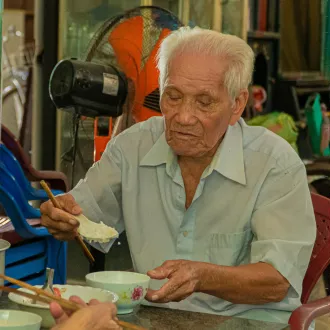Transcription Indicators of malnutrition
Malnutrition in the elderly is a health problem that often goes unnoticed but has significant consequences on the quality of life of older people. As we age, our bodies experience changes in nutrient absorption and metabolism, which can lead to malnutrition if not properly addressed.
In this session, we will explore the indicators of malnutrition in the elderly, how to identify them, and strategies to prevent and address this problem.
The Importance of Nutrition in Older Adults
Nutrition is fundamental at all stages of life, but it takes on critical importance in the elderly. Adequate nutrition is essential for maintaining health, energy and quality of life in the elderly. Nutrients are necessary for proper immune system function, bone health, cognitive function, and blood pressure regulation, among other things.
However, with aging, physiological changes occur that can affect the ability of older people to obtain and utilize nutrients from food. These changes include a decrease in the absorption of certain nutrients, a reduced sense of hunger, and a loss of muscle mass, which can lead to a decrease in food intake.
Indicators of Malnutrition in the Elderly
Malnutrition in the elderly can go unnoticed, but there are key indicators that can help identify this problem. Here are some of the most common indicators:
- Unintentional Weight Loss: One of the most obvious indicators of malnutrition in the elderly is unintentional weight loss. If an older person is losing weight without intending to, this may be a sign that they are not getting enough nutrients. It is important to pay attention to any significant changes in body weight.
- Constant Weakness and Fatigue: Persistent weakness and fatigue are symptoms that the body is not getting the energy it needs from food. Older people who feel weak and tired frequently may be experiencing malnutrition.
- Decreased Appetite: A decrease in appetite is common in the elderly, but when it becomes a significant loss of interest in food, it may be an indicator of malnutrition. This may be due to changes in the sense of taste, dental problems or underlying medical conditions.
- Dental Problems: Dental problems, such as missing teeth or pain in the mouth, can make chewing and eating difficult. This can lead to avoidance of certain foods and contribute to malnutrition.
- Changes in Body Composition: Changes in body composition, such as a decrease in muscle mass or an increase in body fat, may indicate malnutrition. A loss of muscle mass is of particular concern, as it can lead to weakness and frailty.
- Skin and Scarring Problems: Malnutrition can affect skin health and the body's ability to heal. Skin ulcers that do not heal properly can be an indicator of nutritional problems.
- Changes in Cognitive Function: Malnutrition can also affect cognitive function. Changes in memory, concentration and mental clarity may be indicators that the brain is not receiving the necessary nutrients.
Strategies to Prevent and Address Malnutrition.
Preventing and addressing malnutrition in the elderly is critical to maintaining health and quality of life. Here are some key strategies:
- Balanced Eating: Encouraging a balanced diet that includes a variety of nutrient-rich foods is essential. This can include fruits, vegetables, lean proteins, low-fat dairy products and whole grains.
- Nutritional Supplements: In cases where it is difficult to get enough nutrients from food, nutritional supplements may be helpful. Consulting with a health professional or registered dietitian is important before taking supplements.
- Dental Care: Proper dental care is essential to ensure that older people can chew and eat comfortably. Dental problems should be addressed in a timely manner.
- Medical Monitoring: Getting regular medical checkups can help identify nutrition-related health problems. Physicians can assess food intake and provide guidance.
- Social Support: Social support is critical to preventing malnutrition in the elderly. Spending time with friends and family during mealtimes can improve appetite and eating quality.
- Physical Activity: Moderate physical activity can help stimulate appetite and maintain muscle mass. Consulting with a physician before beginning any exercise program is important.
- Nutrition Education: Providing nutrition education to the elderly and their caregivers can increase awareness of the importance of proper nutrition.
malnutrition indicators




